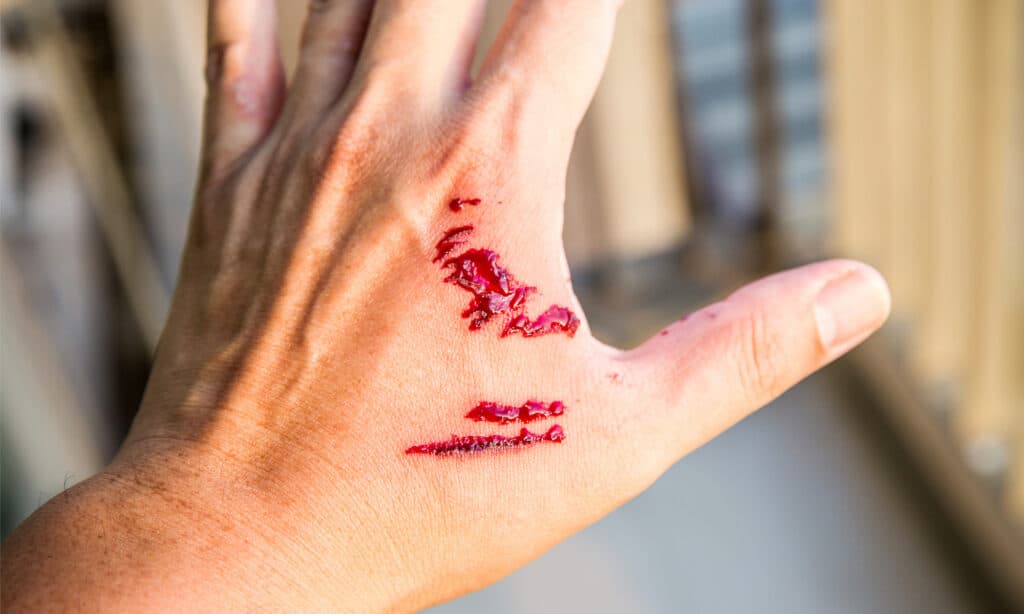Rabies is a viral disease of the nervous system that is passed to humans from animals – specifically mammals. It causes a lot of fear because in many cases it is fatal. In the US, rabies is carried by several wild animals which raises the question of whether foxes can have rabies. Foxes are dog-like omnivorous mammals and there are more than 10 different species. The red fox (Vulpes vulpes) is the most common species found in the US and the one that most people are likely to come into contact with. The red fox is a wild animal but they are often seen in suburban and even urban locations. Here we examine whether foxes can carry rabies and what you should do if you are bitten by one.
What Is Rabies?

Rabies is a viral disease of the nervous system.
©jarun011/iStock via Getty Images
Rabies is a disease that most of us have heard of and there is even a World Rabies Day which falls on 28th September each year. It is caused by a specific virus that belongs to the order Mononegavirales and is classed as an RNA virus. When the virus enters an animal’s body (the host) it invades their cells and multiplies (replicates).
There are several different strains of the rabies virus. These have adapted to infect specific hosts and are found in specific geographical locations in the US.
Foxes carry one such strain which is sometimes called the ‘fox variant’. Other strains are found in raccoons, skunks, and mongooses.
How Can You Catch Rabies?
You catch rabies from the saliva or brain/nervous system tissue of an infected animal. Diseases that are transmitted from animals to humans are called zoonotic diseases. To become infected, you need to have direct contact with this material. This means it needs to enter your body through broken skin or mucous membranes such as your eyes, nose, or mouth.
By far the most common way to contract rabies is through the bite of a rabid animal. Rarely, people are infected through scratches or open wounds. Once the virus has dried out it is no longer infectious so if the material containing the virus is dry it is unlikely to be a risk to you. Is therefore very hard to contract rabies from the environment.
What Are the Symptoms of Rabies in Humans?
Rabies cases in the US are rare – only between one and three cases are reported every year.
This disease affects the central nervous system. Symptoms start typically between two and three months after infection, but it can be as quick as a week or as long as a year. The initial symptoms are quite vague and include fever, pain, and an unusual tingling or burning sensation around the bite wound. As the virus becomes established in the central nervous system, the brain and spinal cord become inflamed. By this stage, a cure is not possible. Once the clinical symptoms appear rabies is almost certainly fatal.
In humans, there are two types of rabies. Furious rabies causes hyperactivity and excitability including hallucinations and hydrophobia (a fear of water). Paralytic rabies is less common and also less dramatic. The victim’s muscles are gradually paralyzed spreading out from the wound site.
Which Animals Carry Rabies?

More people get rabies from bats in the US than from foxes.
©Hermann Moller/Shutterstock.com
Only mammals can potentially get rabies – it does not affect birds, snakes, or fish. In the US, more than 90 percent of reported cases of rabies are in wildlife. There are only a few species that are important reservoirs for the disease – these are the animals that normally carry the virus.
In the United States, important reservoirs for rabies are bats, raccoons, skunks, mongooses, and foxes. Having said that, contact with infected bats is the leading cause of human rabies deaths in the US. Most of these animals transmit rabies amongst themselves and it is unusual for them to infect another species.
Pets and domestic livestock can get rabies. They nearly always contract it from infected wildlife. There are laws requiring dogs to be vaccinated for rabies in the US and recorded cases in pet dogs are low. If we look at the worldwide picture, however, domestic dogs are responsible for more than 90 percent of all human rabies fatalities worldwide.
How Common Is Rabies in Foxes?
Rabies surveillance is carried out each year in animal populations in the US. The data from 2021 shows that 314 foxes were positive. This is similar to levels recorded for several years. No human caught rabies from a fox during this time. Other surveys of trapped carcasses have recorded that 3 percent of red foxes and 5 percent of arctic foxes tested positive for the rabies virus. Therefore, your chances of contracting rabies from a fox are low. Anyone who has a hobby or occupation that makes them more likely to come into contact with foxes is going to be more at risk.
How Can You Tell if a Fox Has Rabies?

Foxes with rabies may appear more aggressive.
©AngelaLouwe/Shutterstock.com
It is not that easy to tell that an animal has rabies by looking at them. The only way to be sure is to carry out medical tests to isolate the virus. Having said that, rabies can change an animal’s behavior. Here are some potential signs that a fox has rabies:
- Fighting or attacking inanimate objects – this is sometimes called fly biting.
- Having no fear of people or appearing tamer than you would expect.
- Seeming unaware of its surroundings or blind.
- Weak, lame, or completely paralyzed.
- Being more aggressive than you would expect.
- Having difficulty swallowing and breathing or salivating more than normal.
- Being dead!
What Other Diseases Can Foxes Carry?

Foxes can carry several pathogens that can be transmitted to humans.
©Ondrej Prosicky/Shutterstock.com
Regardless of whether a fox is carrying rabies or not, getting bitten by one is not a pleasant experience. There is physical trauma to the soft tissues at the location of the bite which is painful. As is the case with domestic dogs, the microorganisms that live in a fox’s mouth have the potential to cause localized infections around the bite wound. In some cases, these infections can spread and affect the rest of the body. Theoretically, humans can also contract Bartonella henselae which causes “cat scratch disease” from fox scratches.
Foxes can carry the pathogen that causes leptospirosis but so can rodents, domestic animals, and livestock. They can also carry various strains of salmonella, campylobacter, and E. coli. These are all bacteria that can cause stomach upsets in humans but can be prevented by washing your hands thoroughly after you have touched a fox or their feces. The same is true for Cryptosporidium parvum.
How to Avoid Getting Rabies From a Fox
For most people, the most sensible thing you can do to protect yourself from catching rabies from a fox is to keep away from foxes! By all means, admire these beautiful creatures from a distance but do not attempt to get too close to them.
Wildlife experts agree that it is not a good idea to feed wild foxes. Encouraging foxes into urban areas puts them in danger of being injured on the roads. Also, it can lead to habituation. This is where a fox becomes so used to a stimulus that they are no longer sensitive to it. That fox no longer views humans as a threat and this is dangerous for them.
Hand-feeding foxes may seem like a cool thing to do but it’s dangerous for both you, the fox, and local ecosystems. Fox bites are potentially dangerous for you and the implicated fox may need to be destroyed. Human food is not good for foxes! Human-fed foxes put on a lot of weight and can have above-average litter sizes. This adds an unusually large number of predators to the ecosystem which can damage other wildlife.
Working with foxes
People who hunt or trap wildlife as a hobby or as their occupation are at a higher risk. They must take steps to prevent brain material, spinal cord, salivary glands, and saliva from coming into contact with their broken skin or mucous membranes. Here are steps that they can take to reduce the risks:
- Avoid shots to the head so that the brain material is not spread outside the skull.
- Use non-porous gloves to handle animals.
- Wash knives with soap and water immediately, especially after severing the head.
- Refrain from eating, drinking, or smoking while skinning or handling wildlife carcasses.
It is also important that fox carcasses are disposed of responsibly so that they do not spread the disease to domestic dogs.
What You Should Do if You Are Bitten by a Fox

If you are bitten by a fox in the US you should assume that it has rabies and get medical treatment.
©iStock.com/kckate16
If you are unfortunate enough to be bitten by a fox (or a raccoon or skunk) you should assume that you have potentially been exposed to the rabies virus. It is vital that you immediately seek medical attention. If the animal can be trapped somewhere it can be tested to determine if it has rabies. It may be carrying the virus even if it appears as well.
Medical experts will thoroughly clean your wound with soap and water. They will also irrigate the wound with a virucidal agent such as a povidone-iodine solution. The next stage is to commence a treatment called post-exposure prophylaxis. This consists of a dose of human rabies immune globulin (HRIG). The treatment is administered to previously unvaccinated people. It immediately provides your body with antibodies to fight off the virus. If possible, this is administered near the wound.
Also, you will be given the rabies vaccine. The first dose is administered as soon as possible and three follow-up doses are given in the following days.
Summing up Can Foxes Have Rabies?
Can foxes have rabies? Yes, and they can transmit it to humans through bites although this is very rare and most human cases in the US are caused by bats. Most cases worldwide are caused by domestic dogs. People who have close contact with foxes are at greatest risk and this is one of the reasons why hand feeding foxes is not a good idea. If you are bitten by a fox, you should assume that it could have rabies and get medical attention right away. This will involve cleaning the wound and administering human rabies immune globulin followed by the rabies vaccine over several days.
The photo featured at the top of this post is © Sandra Standbridge/Shutterstock.com
Thank you for reading! Have some feedback for us? Contact the AZ Animals editorial team.







